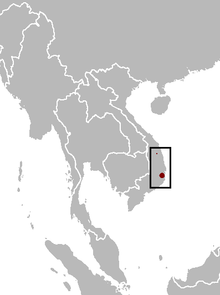Vietnam mouse-deer
| Vietnam mouse-deer | |
|---|---|
| Scientific classification | |
| Domain: | Eukaryota |
| Kingdom: | Animalia |
| Phylum: | Chordata |
| Class: | Mammalia |
| Order: | Artiodactyla |
| Family: | Tragulidae |
| Genus: | Tragulus |
| Species: | T. versicolor
|
| Binomial name | |
| Tragulus versicolor Thomas, 1910
| |

| |
| Range of the Vietnam mouse deer (2008)[1] | |
The Vietnam mouse-deer (Tragulus versicolor), also known as the silver-backed chevrotain, is an
Taxonomy
The Vietnam mouse-deer was first
Status and sightings
Information on the distribution and ecology of this mouse-deer is scarce; it is
Nearly 30 years after the last sighting, a study published in 2019 by researchers associated with the Global Wildlife Conservation confirmed the presence of Vietnam mouse-deer in dry low-lying forests on the southern coast of Vietnam. The researchers had begun with interviews of local people, some of whom suggested the presence of two types of chevrotain in the area; the descriptions indicated the two chevrotains could be the lesser mouse-deer and the Vietnam mouse-deer ('grey-coloured chevrotains'). All interviewees agreed that chevrotain populations had declined over the years in the region due to hunting. Camera traps were set up in areas from where grey chevrotains had been reported; the researchers were successful in capturing images of Vietnam mouse-deer, easily identifiable by their characteristic double-tone coloration and throat markings. The researchers said they aim to further study the size and stability of the populations.[10][11][12]
Physical description
In his 1910 account, Thomas described the Vietnam mouse-deer as having a rough coat, big reddish brown ears, and white and dark reddish brown marks on the throat. He noted the sharp contrast between the reddish brown colour of the front part of the body up to the shoulders, and the grey posterior separated by a line of buff from the white underparts—such stark variation is not observed in other chevrotains. The tail, grey in the upper part and white below, becomes more reddish brown toward the tip, which is white. Per his measurements, the head-and-body length is around 48 cm (19 in) and the tail is 5 cm (2 in) long.[2] Examiners of the 1990 specimen noted its shabrack-like coat with dense fur on the back and white hair tips. A prominent silver line runs down the back, hence the name "silver-backed". The neck and shoulders are more brown with less dense fur; unlike the lesser mouse-deer the fur on the neck is coarser and less prickly. The Vietnam mouse-deer lacks the dark markings along the flanks and the middle portion of the underparts visible in the lesser mouse-deer.[5][13]
Ecology and habitat
The 2019 camera-trap evidence suggests that Vietnam mouse-deer are diurnal (active mainly during the day), and stay solitary or form pairs.[10] The locality where the 1990 specimen was obtained was a low-lying area of semi-deciduous tropical forest; several lesser mouse-deer specimens were found in the same area, suggesting sympatry.[5] The 2019 study observed the Vietnam mouse-deer in dry lowland forest near the southern coast of Vietnam.[10]
See also
References
- ^ . Retrieved 19 November 2021.
- ^ a b Thomas, O. (1910). "Tragulus versicolor". The Annals and Magazine of Natural History. 8. 5 (25–30): 535.
- OCLC 62265494.
- .
- ^ .
- ^ Meijaard, E.; Groves, C.P. (2004). "Recent study identifies the possible existence of a forgotten species". Oryx. 38: 132–133.
- ^ Meijaard, E.; Borissenko, A.V.; Kuznetsov, G.V. (2004). "Rediscovery of Tragulus versicolor, the silver-backed chevrotain". Oryx. 38: 254–255.
- ^ Leahy, S. (11 November 2019). "Fanged mouse-deer identified after vanishing for a generation". National Geographic. Archived from the original on 11 November 2019. Retrieved 10 April 2020.
- ^ "The Search for Lost Species". Global Wildlife Conservation. Archived from the original on 1 August 2017. Retrieved 10 July 2017.
- ^ S2CID 207960701.
- ^ Iati, M. (12 November 2019). "A tiny 'deer' was feared extinct. Scientists just photographed it for the first time in a generation". The Washington Post. Retrieved 10 April 2020.
- ^ Preston, E. (12 November 2019). "This elusive creature wasn't seen for nearly 30 years. Then it appeared on camera". The New York Times. Retrieved 10 April 2020.
- ^ Saplakoglu, Y. (11 November 2019). "A tiny species that looks part-deer, part-mouse was missing for nearly 30 years. Scientists just found it". Live Science. Retrieved 10 April 2020.

